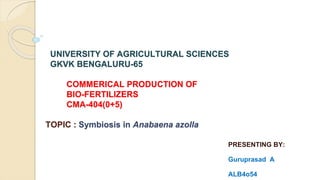
Azolla and Anabena symbiosis
- 1. UNIVERSITY OF AGRICULTURAL SCIENCES GKVK BENGALURU-65 COMMERICAL PRODUCTION OF BIO-FERTILIZERS CMA-404(0+5) TOPIC : Symbiosis in Anabaena azolla PRESENTING BY: Guruprasad A ALB4o54
- 2. Anabaena ● Anabaena is a genus of filamentous cyanobacteria that exists as plankton. ● They form symbiotic relationship with certain plants and fix nitrogen. ● The Genes was identified by Bory de Saint Vincent and Flahault in 1886
- 3. HISTORY ● A DNA sequencing project was undertaken in 1999, and mapped the complete genome of Anabaena, which is 7.2 million base pairs long. ● The study focused on heterocysts, which converts nitrogen into ammonia. ● Certain species of Anabaena have been used in paddy fields proving to be an effective natural fertilizer.
- 4. Anabaena as observed in microscope
- 5. SCIENTIFIC CLASSIFICATION OF Anabaena spp ❑KINGDOM : Bacteria ❑PHYLUM : Cyanobacteria ❑CLASS : Hormogoneae ❑ORDER : Nostocales ❑FAMILY : Nostocaceae ❑GENUS : Anabaena
- 7. AZOLLA: ● Azolla is a genus of common water fern whose small leaves accumulate on the surface of bodies of water creating mats. ● Azolla is also known as mosquito fern or duck weed fern of fairy moss. ● Azolla is highly productive plant it doubles its biomass in 3 to 10 days. ● Azolla is used as an organic biofertilizer to increase the nitrogen levels in paddy. ● The rotting plant material releases nitrogen to the rice plants providing upto 9 tonnes of protein/ha/year.
- 8. SCIENTIFIC CLASSIFICATION OF Azolla fern ●Kingdom : Plantae ●Division : Pteridophyta ●Class : Polypodiopsida ●Order : Salviniales ●Family : Salviniaceae ●Genus : Azolla
- 9. AZOLLA
- 10. About Anabaena azollae: ● It is a small filamentous phototrophic cyanobacteria generally seen as a multicelluar organisms with two distinct interdependent cell types. ● The first cell type is a small circular photoautotrophic vegetative cell that performs oxygenic photosynthesis and is typically blue-green in colour. ● The second is the heterocyst a larger paler more homogeneous cell produced by Anabaena to fix atmospheric nitrogen. ● Anabaena azollae is usually found within ovoid cavities inside the leaves of water fern Azolla.
- 11. Two types of cells, 1. Vegetative cells 2. Heterocyst
- 12. ECOLOGY OF Anabaena azollae ● Anabaena azollae and Azolla have formed a symbiotic relationship in which the cyanobacterium receives carbon and nitrogen sources from the plant in exchange for fixed nitrogen. ● Anabaena azollae are usually found within ovoid cavities located within the plants dorsal leaves and are connected to the external environment by pores. ● Epidermal cells inside the leaf cavities of Azolla project inwards forming numerous multicellular hairs wit wart like outgrowths. ● These hairs are thought to serve as a pathway for the free exchange of nutrients between Anabaena azollae and Azolla.
- 13. Anabaena present in leaf cavities of Azolla
- 14. ● When free living Anabaena azollae develops only 5 to 10% of its cells into heterocyst . But when living in conjunction with Azolla it increases its heterocyst production upto 25 to 30%. • Anabaena azollae is able to fix nitrogen so efficiently that population of Azolla have been known to double their biomass every two to three days.
- 15. Nitrogen fixation ● Nitrogen fixation is a remarkable prokaryotic skill in which inert atmospheric nitrogen gas (N2) is combined with hydrogen to form ammonia (NH3). ● This vital process along with nitrification (formation of nitrites and nitrates) and ammonification (formation of ammonia from protein decay) make nitrogen available to autotrophic plants and ultimately to all members of the ecosystem. ● Although Azolla can absorb nitrates from the water, it can also absorb ammonia secreted by Anabaena within the leaf cavities
- 16. Mechanism ● Under nitrogen-limiting conditions, vegetative cells differentiate into heterocysts at semi-regular intervals along the filaments. ● Heterocysts are cells that are terminally specialized for nitrogen fixation. ● The interior of these cells is microoxic as a result of increased respiration, inactivation of O2 producing photosystem (PS) II, and formation of a thickened envelope outside of the cell wall.
- 17. ● Nitrogenase, sequestered within these cells, transforms dinitrogen into ammonium at the expense of ATP and reductant—both generated by carbohydrate metabolism, a process that is supplemented, in the light, by the activity of PS I. ● Carbohydrate, probably in the form of sucrose, is synthesized in vegetative cells and moves into heterocysts. ● In return, nitrogen fixed in heterocysts moves into the vegetative cells, at least in part in the form of amino acids
- 18. Energy demand in Nitrogen fixation Two molecules of ammonia are produced from one molecule of nitrogen gas. The reaction requires 16 molecules of ATP and a supply of electrons and protons (hydrogen ions) plus the enzyme nitrogenase.
- 19. Symbiotic N2-fixation: Azolla - Anabena
- 20. IMPORTANCE OF Anabaena azollae ● For centuries the symbiotic relationship between Anabaena azollae and Azolla has benefitted farmers across world. ● It is commonly used as green manure which increases rice production. ● It is either incorporated as green manure at the beginning of the cropping season or grown as dual crop along with rice crop. ● Azolla can also provide aerobic transformations such as metane oxidation through enhance aeration of flood water in rice field. .
- 21. ● The fern is responsible for providing 50 to 75% of the nitrogen required by the rice crop. ● According to some reports Azolla has helped increase rice yields as much as 158% per year. ● Azolla is also used in fish food and garden mulch. ● It is a natural food for various types of insects. ● It is also used as water purifier and for control of weeds and mosquitoes.
- 22. Rice-Azolla-Fish, China Azolla to feed cows, Thailand Rice-Azolla-Ducks, Korea Takao Furuno Symbiotic N2-fixation: Azolla - Anabena
- 23. AZOLLA FERTILIZED IN PADDY FIELDS
- 24. Thank you